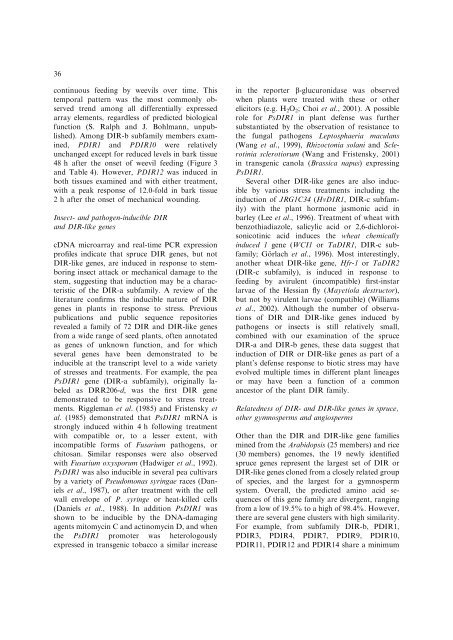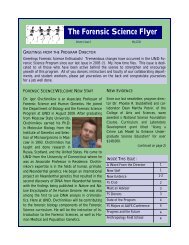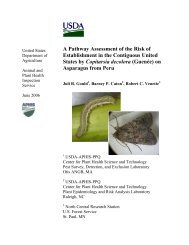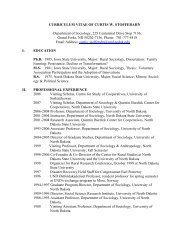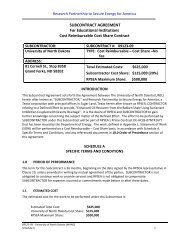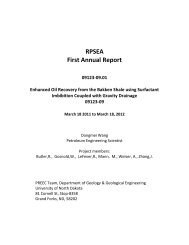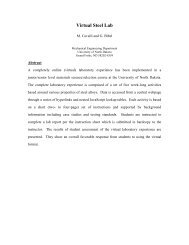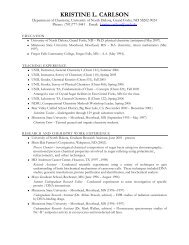Dirigent proteins in conifer defense: gene discovery, phylogeny, and ...
Dirigent proteins in conifer defense: gene discovery, phylogeny, and ...
Dirigent proteins in conifer defense: gene discovery, phylogeny, and ...
You also want an ePaper? Increase the reach of your titles
YUMPU automatically turns print PDFs into web optimized ePapers that Google loves.
36<br />
cont<strong>in</strong>uous feed<strong>in</strong>g by weevils over time. This<br />
temporal pattern was the most commonly observed<br />
trend among all differentially expressed<br />
array elements, regardless of predicted biological<br />
function (S. Ralph <strong>and</strong> J. Bohlmann, unpublished).<br />
Among DIR-b subfamily members exam<strong>in</strong>ed,<br />
PDIR1 <strong>and</strong> PDIR10 were relatively<br />
unchanged except for reduced levels <strong>in</strong> bark tissue<br />
48 h after the onset of weevil feed<strong>in</strong>g (Figure 3<br />
<strong>and</strong> Table 4). However, PDIR12 was <strong>in</strong>duced <strong>in</strong><br />
both tissues exam<strong>in</strong>ed <strong>and</strong> with either treatment,<br />
with a peak response of 12.0-fold <strong>in</strong> bark tissue<br />
2 h after the onset of mechanical wound<strong>in</strong>g.<br />
Insect- <strong>and</strong> pathogen-<strong>in</strong>ducible DIR<br />
<strong>and</strong> DIR-like <strong>gene</strong>s<br />
cDNA microarray <strong>and</strong> real-time PCR expression<br />
profiles <strong>in</strong>dicate that spruce DIR <strong>gene</strong>s, but not<br />
DIR-like <strong>gene</strong>s, are <strong>in</strong>duced <strong>in</strong> response to stembor<strong>in</strong>g<br />
<strong>in</strong>sect attack or mechanical damage to the<br />
stem, suggest<strong>in</strong>g that <strong>in</strong>duction may be a characteristic<br />
of the DIR-a subfamily. A review of the<br />
literature confirms the <strong>in</strong>ducible nature of DIR<br />
<strong>gene</strong>s <strong>in</strong> plants <strong>in</strong> response to stress. Previous<br />
publications <strong>and</strong> public sequence repositories<br />
revealed a family of 72 DIR <strong>and</strong> DIR-like <strong>gene</strong>s<br />
from a wide range of seed plants, often annotated<br />
as <strong>gene</strong>s of unknown function, <strong>and</strong> for which<br />
several <strong>gene</strong>s have been demonstrated to be<br />
<strong>in</strong>ducible at the transcript level to a wide variety<br />
of stresses <strong>and</strong> treatments. For example, the pea<br />
PsDIR1 <strong>gene</strong> (DIR-a subfamily), orig<strong>in</strong>ally labeled<br />
as DRR206-d, was the first DIR <strong>gene</strong><br />
demonstrated to be responsive to stress treatments.<br />
Riggleman et al. (1985) <strong>and</strong> Fristensky et<br />
al. (1985) demonstrated that PsDIR1 mRNA is<br />
strongly <strong>in</strong>duced with<strong>in</strong> 4 h follow<strong>in</strong>g treatment<br />
with compatible or, to a lesser extent, with<br />
<strong>in</strong>compatible forms of Fusarium pathogens, or<br />
chitosan. Similar responses were also observed<br />
with Fusarium oxysporum (Hadwiger et al., 1992).<br />
PsDIR1 was also <strong>in</strong>ducible <strong>in</strong> several pea cultivars<br />
by a variety of Pseudomonas syr<strong>in</strong>gae races (Daniels<br />
et al., 1987), or after treatment with the cell<br />
wall envelope of P. syr<strong>in</strong>ge or heat-killed cells<br />
(Daniels et al., 1988). In addition PsDIR1 was<br />
shown to be <strong>in</strong>ducible by the DNA-damag<strong>in</strong>g<br />
agents mitomyc<strong>in</strong> C <strong>and</strong> act<strong>in</strong>omyc<strong>in</strong> D, <strong>and</strong> when<br />
the PsDIR1 promoter was heterologously<br />
expressed <strong>in</strong> transgenic tobacco a similar <strong>in</strong>crease<br />
<strong>in</strong> the reporter b-glucuronidase was observed<br />
when plants were treated with these or other<br />
elicitors (e.g. H 2 O 2 ; Choi et al., 2001). A possible<br />
role for PsDIR1 <strong>in</strong> plant <strong>defense</strong> was further<br />
substantiated by the observation of resistance to<br />
the fungal pathogens Leptosphaeria maculans<br />
(Wang et al., 1999), Rhizoctonia solani <strong>and</strong> Sclerot<strong>in</strong>ia<br />
sclerotiorum (Wang <strong>and</strong> Fristensky, 2001)<br />
<strong>in</strong> transgenic canola (Brassica napus) express<strong>in</strong>g<br />
PsDIR1.<br />
Several other DIR-like <strong>gene</strong>s are also <strong>in</strong>ducible<br />
by various stress treatments <strong>in</strong>clud<strong>in</strong>g the<br />
<strong>in</strong>duction of JRG1C34 (HvDIR1, DIR-c subfamily)<br />
with the plant hormone jasmonic acid <strong>in</strong><br />
barley (Lee et al., 1996). Treatment of wheat with<br />
benzothiadiazole, salicylic acid or 2,6-dichloroisonicot<strong>in</strong>ic<br />
acid <strong>in</strong>duces the wheat chemically<br />
<strong>in</strong>duced 1 <strong>gene</strong> (WCI1 or TaDIR1, DIR-c subfamily;<br />
Go¨rlach et al., 1996). Most <strong>in</strong>terest<strong>in</strong>gly,<br />
another wheat DIR-like <strong>gene</strong>, Hfr-1 or TaDIR2<br />
(DIR-c subfamily), is <strong>in</strong>duced <strong>in</strong> response to<br />
feed<strong>in</strong>g by avirulent (<strong>in</strong>compatible) first-<strong>in</strong>star<br />
larvae of the Hessian fly (Mayetiola destructor),<br />
but not by virulent larvae (compatible) (Williams<br />
et al., 2002). Although the number of observations<br />
of DIR <strong>and</strong> DIR-like <strong>gene</strong>s <strong>in</strong>duced by<br />
pathogens or <strong>in</strong>sects is still relatively small,<br />
comb<strong>in</strong>ed with our exam<strong>in</strong>ation of the spruce<br />
DIR-a <strong>and</strong> DIR-b <strong>gene</strong>s, these data suggest that<br />
<strong>in</strong>duction of DIR or DIR-like <strong>gene</strong>s as part of a<br />
plant’s <strong>defense</strong> response to biotic stress may have<br />
evolved multiple times <strong>in</strong> different plant l<strong>in</strong>eages<br />
or may have been a function of a common<br />
ancestor of the plant DIR family.<br />
Relatedness of DIR- <strong>and</strong> DIR-like <strong>gene</strong>s <strong>in</strong> spruce,<br />
other gymnosperms <strong>and</strong> angiosperms<br />
Other than the DIR <strong>and</strong> DIR-like <strong>gene</strong> families<br />
m<strong>in</strong>ed from the Arabidopsis (25 members) <strong>and</strong> rice<br />
(30 members) genomes, the 19 newly identified<br />
spruce <strong>gene</strong>s represent the largest set of DIR or<br />
DIR-like <strong>gene</strong>s cloned from a closely related group<br />
of species, <strong>and</strong> the largest for a gymnosperm<br />
system. Overall, the predicted am<strong>in</strong>o acid sequences<br />
of this <strong>gene</strong> family are divergent, rang<strong>in</strong>g<br />
from a low of 19.5% to a high of 98.4%. However,<br />
there are several <strong>gene</strong> clusters with high similarity.<br />
For example, from subfamily DIR-b, PDIR1,<br />
PDIR3, PDIR4, PDIR7, PDIR9, PDIR10,<br />
PDIR11, PDIR12 <strong>and</strong> PDIR14 share a m<strong>in</strong>imum


